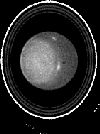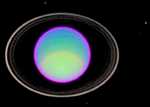
 |
 Uranus is the seventh planet from the Sun
and the third largest (by diameter).
Uranus is larger in diameter but smaller in mass than
Neptune.
Uranus is the seventh planet from the Sun
and the third largest (by diameter).
Uranus is larger in diameter but smaller in mass than
Neptune.
orbit: 2,870,990,000 km (19.218 AU) from Sun
diameter: 51,118 km (equatorial)
mass: 8.683e25 kg
Careful pronounciation may be necessary
to avoid embarassment; say "YOOR a nus"  , not "your anus" or "urine us".
, not "your anus" or "urine us".
Uranus is the ancient Greek deity of the Heavens, the earliest supreme god. Uranus was the son and mate of Gaia the father of Cronus (Saturn) and of the Cyclopes and Titans (predecessors of the Olympian gods).
Uranus, the first planet discovered in modern times, was discovered by William Herschel while systematicly searching the sky with his telescope on March 13, 1781. It had actually been seen many times before but ignored as simply another star (the earliest recorded sighting was in 1690 when John Flamsteed cataloged it as 34 Tauri). Herschel named it "the Georgium Sidus" (the Georgian Planet) in honor of his patron, the infamous (to Americans) King George III of England; others called it "Herschel". The name "Uranus" was first proposed by Bode in conformity with the other planetary names from classical mythology but didn't come into common use until 1850.
Uranus has been visited by only one spacecraft, Voyager 2 on Jan 24 1986.
 Most of the planets spin on an axis nearly perpendicular to the plane of
the ecliptic but Uranus' axis is almost
parallel to the ecliptic.
At the time of Voyager 2's passage,
Uranus' south pole was pointed almost directly at the Sun.
This results in the odd fact that Uranus' polar regions receive more energy
input from the Sun than do its equatorial regions.
Uranus is nevertheless hotter at its equator than at its poles. The mechanism
underlying this is unknown.
Most of the planets spin on an axis nearly perpendicular to the plane of
the ecliptic but Uranus' axis is almost
parallel to the ecliptic.
At the time of Voyager 2's passage,
Uranus' south pole was pointed almost directly at the Sun.
This results in the odd fact that Uranus' polar regions receive more energy
input from the Sun than do its equatorial regions.
Uranus is nevertheless hotter at its equator than at its poles. The mechanism
underlying this is unknown.
Actually, there's an ongoing battle over which of Uranus' poles is its north pole! Either its axial inclination is a bit over 90 degrees and its rotation is direct, or it's a bit less than 90 degrees and the rotation is retrograde. The problem is that you need to draw a dividing line *somewhere*, because in a case like Venus there is little dispute that the rotation is indeed retrograde (not a direct rotation with an inclination of nearly 180).
Uranus is composed primarily of rock and various ices, with only about 15% hydrogen and a little helium (in contrast to Jupiter and Saturn which are mostly hydrogen). Uranus (and Neptune) are in many ways similar to the cores of Jupiter and Saturn minus the massive liquid metallic hydrogen envelope. It appears that Uranus does not have a rocky core like Jupiter and Saturn but rather that its material is more or less uniformly distributed.
Uranus' atmosphere is about 83% hydrogen, 15% helium and 2% methane.
 Like the other gas planets, Uranus has bands of clouds that blow around
Like the other gas planets, Uranus has bands of clouds that blow around
 rapidly. But they are extremely faint, visible only with radical image
enhancement of the Voyager 2 pictures
(right).
Recent observations with HST (left)
show larger and
more pronounced streaks.
Further HST observations
show even more activity. Uranus is no longer the bland boring planet that Voyager saw!
It now seems clear that the differences are due to
seasonal effects since the Sun is now at a lower Uranian latitude which may
cause more pronounced day/night weather effects.
By 2007 the Sun will be directly over Uranus's equator.
rapidly. But they are extremely faint, visible only with radical image
enhancement of the Voyager 2 pictures
(right).
Recent observations with HST (left)
show larger and
more pronounced streaks.
Further HST observations
show even more activity. Uranus is no longer the bland boring planet that Voyager saw!
It now seems clear that the differences are due to
seasonal effects since the Sun is now at a lower Uranian latitude which may
cause more pronounced day/night weather effects.
By 2007 the Sun will be directly over Uranus's equator.
Uranus' blue color is the result of absorption of red light by methane in the upper atmosphere. There may be colored bands like Jupiter's but they are hidden from view by the overlaying methane layer.
 Like the other gas planets, Uranus has rings.
Like Jupiter's, they are very dark but like Saturn's composed of fairly large
particles ranging up to 10 meters in diameter in addition to fine dust.
There are 11 known rings, all very faint; the brightest is known as
the Epsilon ring.
The Uranian rings were the first after Saturn's to be discovered. This was of
considerable importance since we now know that rings are a common feature of
planets, not a peculiarity of Saturn alone.
Like the other gas planets, Uranus has rings.
Like Jupiter's, they are very dark but like Saturn's composed of fairly large
particles ranging up to 10 meters in diameter in addition to fine dust.
There are 11 known rings, all very faint; the brightest is known as
the Epsilon ring.
The Uranian rings were the first after Saturn's to be discovered. This was of
considerable importance since we now know that rings are a common feature of
planets, not a peculiarity of Saturn alone.
Voyager 2 discovered 10 small moons in addition to the 5 large ones already known. It is likely that there are several more tiny satellites within the rings.
Uranus' magnetic field is odd in that it is not centered on the center of the planet and is tilted almost 60 degrees with respect to the axis of rotation. It is probably generated by motion at relatively shallow depths within Uranus.
Uranus is sometimes just barely visible with the naked eye on a very clear night; it is fairly easy to spot with binoculars (if you know exactly where to look). A small astronomical telescope will show a small disk. There are several Web sites that show the current position of Uranus (and the other planets) in the sky, but much more detailed charts will be required to actually find it. Such charts can be created with a planetarium program such as Starry Night.

Distance Radius Mass Satellite (000 km) (km) (kg) Discoverer Date --------- -------- ------ ------- ---------- ----- Cordelia 50 13 ? Voyager 2 1986 Ophelia 54 16 ? Voyager 2 1986 Bianca 59 22 ? Voyager 2 1986 Cressida 62 33 ? Voyager 2 1986 Desdemona 63 29 ? Voyager 2 1986 Juliet 64 42 ? Voyager 2 1986 Portia 66 55 ? Voyager 2 1986 Rosalind 70 27 ? Voyager 2 1986 Belinda 75 34 ? Voyager 2 1986 1986U10 75 20 ? Karkoschka 1999 Puck 86 77 ? Voyager 2 1985 Miranda 130 236 6.30e19 Kuiper 1948 Ariel 191 579 1.27e21 Lassell 1851 Umbriel 266 585 1.27e21 Lassell 1851 Titania 436 789 3.49e21 Herschel 1787 Oberon 583 761 3.03e21 Herschel 1787 Caliban 7200 30 ? Gladman 1997 Sycorax 12200 60 ? Gladman 1997
Distance Width Ring (km) (km) ------- -------- ----- 1986U2R 38000 2,500 6 41840 1-3 5 42230 2-3 4 42580 2-3 Alpha 44720 7-12 Beta 45670 7-12 Eta 47190 0-2 Gamma 47630 1-4 Delta 48290 3-9 1986U1R 50020 1-2 Epsilon 51140 20-100(distance is from Uranus' center to the ring's inner edge)